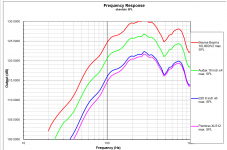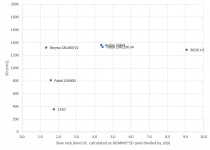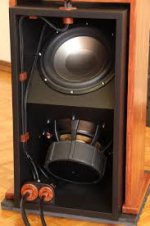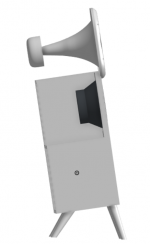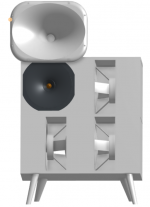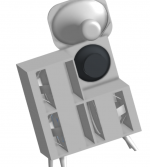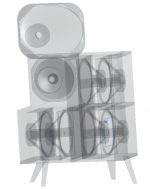Hey. Thought i would ask your opinion on the importance of the bass driver(s) to be used in an open baffle application.
For context, the mid-range and highs will be played by drivers I already have: Audio Nirvana Super 10 CF (150 - 600 Hz) and 18Sound ND1480A on the XT1464 horns. Filters and EQ are managed digitally before DA conversion.
Alas, the lows are currently played by a sorry-*** old single 8" vented box. Using it is a crime and pretty much ruins the system.
After a lot of soul searching and thinking about potential cardioid setups, I have now decided, that midrange and the lower notes down to 40Hz will be open baffle with the option to include a sub for the lowest octave and cardioid experiments.
What got me was a review of the SoundKaos' open baffle model using a Beyma 18LX60/V2. That could work. But large drivers have heavy cones, which essentially limits the driver slew rate. Looking at cone weight and motor force, the CF10 has 5 times more power per weight. Even if you factor in the 4x difference in cone size, the CF10 would be able to move the same amount of air, but still around 25% faster. Odd.
This got me thinking about drivers with light cones, but low Fs and hopefully cheap. Visaton BG20 is one, so i thought having 6 of them on a circular baffle. The summed SD of six of them is equivalent to the Beyma, but the overall moving mass is more than 3x lower and driving force is more than 50% higher. Xmax of 4mm p-p is a problem, but absolute SPL on an 85cm baffle is still 102db at 40Hz. That seems adequate. Especially if a sub is added at a later date.
Also, both drivers need similar levels of EQ at the lower end, albeit the 18 has a lower resonance frequency and thus can play a little bit lower.
To illustrate the point i have added the room response curves and a kind of a slew rate calculation for an assortment of drivers.
For context, the mid-range and highs will be played by drivers I already have: Audio Nirvana Super 10 CF (150 - 600 Hz) and 18Sound ND1480A on the XT1464 horns. Filters and EQ are managed digitally before DA conversion.
Alas, the lows are currently played by a sorry-*** old single 8" vented box. Using it is a crime and pretty much ruins the system.
After a lot of soul searching and thinking about potential cardioid setups, I have now decided, that midrange and the lower notes down to 40Hz will be open baffle with the option to include a sub for the lowest octave and cardioid experiments.
What got me was a review of the SoundKaos' open baffle model using a Beyma 18LX60/V2. That could work. But large drivers have heavy cones, which essentially limits the driver slew rate. Looking at cone weight and motor force, the CF10 has 5 times more power per weight. Even if you factor in the 4x difference in cone size, the CF10 would be able to move the same amount of air, but still around 25% faster. Odd.
This got me thinking about drivers with light cones, but low Fs and hopefully cheap. Visaton BG20 is one, so i thought having 6 of them on a circular baffle. The summed SD of six of them is equivalent to the Beyma, but the overall moving mass is more than 3x lower and driving force is more than 50% higher. Xmax of 4mm p-p is a problem, but absolute SPL on an 85cm baffle is still 102db at 40Hz. That seems adequate. Especially if a sub is added at a later date.
Also, both drivers need similar levels of EQ at the lower end, albeit the 18 has a lower resonance frequency and thus can play a little bit lower.
To illustrate the point i have added the room response curves and a kind of a slew rate calculation for an assortment of drivers.
Attachments
Heavy cones...
First, consider the motor force/mass ratio instead of the mass alone. Ah you did... but:
Second, consider that you might want the cone to act as a piston and not break up.
Third, what do you think a lowpass filter does with ‘slew rate’?
And I probably forget some things, like Vd and thermal behavior.
Think rational, don’t focus on irrelevant aspects.
[edit] really, check the Vd of both options. You need sixteen Visatons, not six.
First, consider the motor force/mass ratio instead of the mass alone. Ah you did... but:
Second, consider that you might want the cone to act as a piston and not break up.
Third, what do you think a lowpass filter does with ‘slew rate’?
And I probably forget some things, like Vd and thermal behavior.
Think rational, don’t focus on irrelevant aspects.
[edit] really, check the Vd of both options. You need sixteen Visatons, not six.
Last edited:
Thank you for the comment.
Here and there people swear by having drivers with light cones. Seemingly not just for midrange and higher, but also midbass. Claims such as "15 inches below 80gr os a must".
Low pass certainly adds about 1ms of group delay, which apparently is not audible in the lower midrange. And yes, this does beg the question whether one could then hear the difference in slew rate.
Maybe someone knows an AES paper or smth discussing the "speed" or slew rate acceptable or audible at certain frequencies.
Here and there people swear by having drivers with light cones. Seemingly not just for midrange and higher, but also midbass. Claims such as "15 inches below 80gr os a must".
Low pass certainly adds about 1ms of group delay, which apparently is not audible in the lower midrange. And yes, this does beg the question whether one could then hear the difference in slew rate.
Maybe someone knows an AES paper or smth discussing the "speed" or slew rate acceptable or audible at certain frequencies.
One factor that seems to be largely ignored, or less emphasized, by people when they debate about the proper weight of the cone of an OB woofer, is the reaction force on the baffle when the woofer cone moves back and forth. This factor can perhaps be ignored when the woofer cone is relatively light, but it can cause problems if the cone is very heavy. It is an implementation issue, and is a much more "real" problem than the worries about a heavy cone not being able to sound good.
I once put a Dayton Ultimax subwoofer driver on a 1/2"-thick piece of plexiglass (~ 42"x30"). It was amusing to see the baffle shaking and bouncing around while the driver played some deep loud bass notes. The weight of that driver is a whopping 280g (just looked it up at Parts Express). So, more than half a pound of mass was being pushed by the powerful motor. Since I did not intend to build super-heavy and super-rigid baffles, I scratched the idea of using the Ultimax driver on OB.
So, to answer the question of whether one 15" woofer or multiple 8" woofers would be more advantageous to use on OB, one relevant thing among others to consider would be a comparison of the mass of the cone of the 15" woofer with the summed mass of the cones of the 8" woofers, assuming that the Sd of the 15" driver is close the summed Sd of the 8" drivers. In this regard, even among 15" woofers, a 15" driver with a lighter cone might be a "better" choice than one with a supper heavy cone, not because "a lighter cone sounds better," but because the vibration problem would be less severe.
I once put a Dayton Ultimax subwoofer driver on a 1/2"-thick piece of plexiglass (~ 42"x30"). It was amusing to see the baffle shaking and bouncing around while the driver played some deep loud bass notes. The weight of that driver is a whopping 280g (just looked it up at Parts Express). So, more than half a pound of mass was being pushed by the powerful motor. Since I did not intend to build super-heavy and super-rigid baffles, I scratched the idea of using the Ultimax driver on OB.
So, to answer the question of whether one 15" woofer or multiple 8" woofers would be more advantageous to use on OB, one relevant thing among others to consider would be a comparison of the mass of the cone of the 15" woofer with the summed mass of the cones of the 8" woofers, assuming that the Sd of the 15" driver is close the summed Sd of the 8" drivers. In this regard, even among 15" woofers, a 15" driver with a lighter cone might be a "better" choice than one with a supper heavy cone, not because "a lighter cone sounds better," but because the vibration problem would be less severe.
Thank you for this link! The nifty "accelerometer" on Hornresponse makes the essence and impact of the slew rate rather clear - it essentially translates to efficiency/sensitivity. Since i have no qualms about using chip amps for the bass region, this does not make that much of a difference.
I made a quick calculation of moving mass vs the combined weight of speakers and baffle. It is ~0.7%. One of the questions now is wether to do "Wharferdale" and leave a cavity for sand between the plywood layers. Might do that for the cool factor and resonance damping anyways.
I think an array of smaller drivers can be advantageous. Apart from getting all things equal (that is certainly not the case with the beyma and the visatons mentioned) it opens up possibilities to influence the modal sound field in you room, whereas a single driver doesn’t. Arranging them in a vertical line e.g. reduces floor-ceiling resonances. In free field conditions (but that is largely irrelevant in normal rooms with these frequency ranges) the directivity of the system can also be controlled by spacing the drivers.
So, multiple drivers have their advantages, but not in slew rate. Or whatever. We have tweeters for slew rate. And you still need at least sixteen BG20’s to get anywhere near the output capabilities of the Beyma...
So, multiple drivers have their advantages, but not in slew rate. Or whatever. We have tweeters for slew rate. And you still need at least sixteen BG20’s to get anywhere near the output capabilities of the Beyma...
Last edited:
A single 15" per channel is often cheaper, and easier to build. Less material, less wire, less work overall.
Why not have 2x15" per channel?
Then you can do the force cancellation thing, much more beneficial IMO, double 15" has almost equal SD to a single 21". Probably still cheaper and easier.
Does not have to take up a whole lot of real-estate.
Edit:
I see you mention the dual plywood + sand layer thing, IMO complete waste of time and effort. Dual 15", mounted for force cancellation, no need for thicker than 15mm ply.
Use 18mm if you want to "over build".
Why not have 2x15" per channel?
Then you can do the force cancellation thing, much more beneficial IMO, double 15" has almost equal SD to a single 21". Probably still cheaper and easier.
Does not have to take up a whole lot of real-estate.
Edit:
I see you mention the dual plywood + sand layer thing, IMO complete waste of time and effort. Dual 15", mounted for force cancellation, no need for thicker than 15mm ply.
Use 18mm if you want to "over build".
Last edited:
Thanks for all the input, guys!
Indeed, what i have on the table are 2x15" and 4x10". I am leaning towards the 10s because of the WAF. My better half thinks the Beosound 9 looks lovely and making the speaker look anything similar to that one i will have to use slimmer speakers. With the 15 cm depth of the 15s, let alone 20+ cm for the 18, i cannot have the nice slim look of the baffle.
Besides looking for a slim looking design, with the 10s i can also fit the horn "inside" the speaker. Being 30cm in length together with the driver it will be sticking out the back, but that is fine as it will not detract from the overall "slim" aesthetic. With the larger drivers I would have to mount the ugly thing on top. One issue to note is, that to get anywhere near the 70 cm diameter of the Beosound the horn and the woofers will need to overlap partially, but at least in preliminary CAD sketches it looks doable. Well, at around 76cm diameter it does. 6x8s could fit at 72cm diameter.
About inverting one half of the speakers. Indeed, with the 10s it would be nice to switch one pair around (connected out of phase) for a more linear response. There is one issue with that though - to keep the design slim i would need to have a stepped baffle where the inverted speakers would be moved approx 10cm backwards. I don't see this causing any problems as the distances are negligible at the intended crossover at ~150-200Hz, but somehow it seems like an overcomplication. Especially as we will be listening mostly at 70-80db where cone movement is nearly nonexistent.
I think for force cancelling, which would negate the use of an as-sturdy-as-feasible baffle, one would need to use a Ripole or a W-frame or other folded baffle solutions. I have considered those, but .... to have them really slim the way the Beosound 9 is slim, i would have to go for 4" drivers. That would be heaps of fun, but it would also have to be a money no object project and i am not even sure there would be enough baffle space to include the required SD - to get the same cone area as 4x10" i would need 14-16 of those. Sure, i could get some which cost a tenner a piece, but i don't know of any cheap ones with an Fs below 40. Xmax is usually also a bit of a challenge for them.
Edit: oh, the actual speaker my wife likes is the Beoplay A9. Sry for the confusion.
Indeed, what i have on the table are 2x15" and 4x10". I am leaning towards the 10s because of the WAF. My better half thinks the Beosound 9 looks lovely and making the speaker look anything similar to that one i will have to use slimmer speakers. With the 15 cm depth of the 15s, let alone 20+ cm for the 18, i cannot have the nice slim look of the baffle.
Besides looking for a slim looking design, with the 10s i can also fit the horn "inside" the speaker. Being 30cm in length together with the driver it will be sticking out the back, but that is fine as it will not detract from the overall "slim" aesthetic. With the larger drivers I would have to mount the ugly thing on top. One issue to note is, that to get anywhere near the 70 cm diameter of the Beosound the horn and the woofers will need to overlap partially, but at least in preliminary CAD sketches it looks doable. Well, at around 76cm diameter it does. 6x8s could fit at 72cm diameter.
About inverting one half of the speakers. Indeed, with the 10s it would be nice to switch one pair around (connected out of phase) for a more linear response. There is one issue with that though - to keep the design slim i would need to have a stepped baffle where the inverted speakers would be moved approx 10cm backwards. I don't see this causing any problems as the distances are negligible at the intended crossover at ~150-200Hz, but somehow it seems like an overcomplication. Especially as we will be listening mostly at 70-80db where cone movement is nearly nonexistent.
I think for force cancelling, which would negate the use of an as-sturdy-as-feasible baffle, one would need to use a Ripole or a W-frame or other folded baffle solutions. I have considered those, but .... to have them really slim the way the Beosound 9 is slim, i would have to go for 4" drivers. That would be heaps of fun, but it would also have to be a money no object project and i am not even sure there would be enough baffle space to include the required SD - to get the same cone area as 4x10" i would need 14-16 of those. Sure, i could get some which cost a tenner a piece, but i don't know of any cheap ones with an Fs below 40. Xmax is usually also a bit of a challenge for them.
Edit: oh, the actual speaker my wife likes is the Beoplay A9. Sry for the confusion.
Last edited:
W folded OB is a good option for double 15", you'd need maybe 10cm more width compared to 10", pending on how you build it.
Another option for force cancellation might be double 12" in a sealed box, would be easier to build. Width would be compareable to a W OB with 10"s, perhaps even a touch slimmer.
The Beyma 12BR70 would be on the top of my list if this was an option, affordable, 31hz fs, 0.5qts, 6-8mm xmax (enough for most home use).
Edit:
I do like my woofers on the front though, if I was in the market for some good 10"s I'd buy the SEAS A26RE4.
Another option for force cancellation might be double 12" in a sealed box, would be easier to build. Width would be compareable to a W OB with 10"s, perhaps even a touch slimmer.
The Beyma 12BR70 would be on the top of my list if this was an option, affordable, 31hz fs, 0.5qts, 6-8mm xmax (enough for most home use).
Edit:
I do like my woofers on the front though, if I was in the market for some good 10"s I'd buy the SEAS A26RE4.
Last edited:
I think the OP wants to build an open baffle system with regard to the drivers to be selected. 4 x 10” probably won’t bring you enough deep bass though, unless you pick sub drivers with enough Xmax. You really need volume displacement with OB.
I think the OP wants to build an open baffle system with regard to the drivers to be selected. 4 x 10” probably won’t bring you enough deep bass though, unless you pick sub drivers with enough Xmax. You really need volume displacement with OB.
Quite right, double 15"'s or 12"s would probably get you close though.
A single 10" (per channel) in a well calculated vented box would probably also be adequate.
Shoddy marketing work in combination with money-grab focus has ruined the reputation of bass reflex, it's all in the implementation.
hear, here !
If there was as much devotion over the last 20+ years, to perfecting a "quiet box" for bass enclosures, as there has been for open baffle, I believe we, as DIY-hobbyists, would be a lot further.
If there was as much devotion over the last 20+ years, to perfecting a "quiet box" for bass enclosures, as there has been for open baffle, I believe we, as DIY-hobbyists, would be a lot further.
Hi,
Beyma 12BR70 would be my choice as well for a slim OB. 2 of them per side of course as minimum.
All the best
Mattes
Beyma 12BR70 would be my choice as well for a slim OB. 2 of them per side of course as minimum.
All the best
Mattes
Egert wants the bass unit to go only up to 150Hz xo. I understood that dsp eq is used, so I would use 2x 12 or 15"" low Fs drivers in W-baffle with with as wide baffle as possible.High Xmax is mandatory and some sort of force cancellation as well.
A friend has 2x12" Peerless SLS in H frame and excursion is huge with high spl...Dayton Ultimax 12" looks pertty good...
Loudspeaker Database
A friend has 2x12" Peerless SLS in H frame and excursion is huge with high spl...Dayton Ultimax 12" looks pertty good...
Loudspeaker Database
Hi,
Beyma 12BR70 would be my choice as well for a slim OB. 2 of them per side of course as minimum.
All the best
Mattes
OB 3-way with Beyma
Double 12" like the Beyma 12BR70 is not *that* far away from the displacement of a single 18", and with the 8mm xmax I think it should be adequate for most livingroom scenarios.
Double 10" is ca 700cm2
vs
Single 15" ca 855cm2
vs
Double 12" ca 1080cm2
vs
Single 18" ca 1250cm2
vs
Double 15" ca 1710cm2
vs
Single 21" ca 1730cm2
Probably a good idea to add a HP filter around 30hz anyway. But then you might as well make a decent BR box instead, because of added group delay from low frequency filters...
Edit2:
I'd pick 12"s or 15"s any day over 10"s, 18"s and 21"s.
Because it's easier to find drivers that are cheap, have a good displacement (sd+xmax) and useable parameters.
Get more for the money using double 15"s IMO.
Double 10" is ca 700cm2
vs
Single 15" ca 855cm2
vs
Double 12" ca 1080cm2
vs
Single 18" ca 1250cm2
vs
Double 15" ca 1710cm2
vs
Single 21" ca 1730cm2
Probably a good idea to add a HP filter around 30hz anyway. But then you might as well make a decent BR box instead, because of added group delay from low frequency filters...
Edit2:
I'd pick 12"s or 15"s any day over 10"s, 18"s and 21"s.
Because it's easier to find drivers that are cheap, have a good displacement (sd+xmax) and useable parameters.
Get more for the money using double 15"s IMO.
Last edited:
I hear you all who make the case for force cancelling and out of phase back to back W-Frames or the RiPole.
The issue with those is that they are visually "difficult". Stacking them can work, but i need 60-70cm of path difference for the midrange as without that i would need to apply eq right at the crossover point, which messes up the phase.
Another issue is the resonance point of W-Frames/RiPoles, which is equal to quarter of the wavelength of the slot depth. With 10" drivers that would be around 350 Hz. Managed digitally this should not be too bad for a 150Hz crossover.
So I gobbled together a sketch. If I manage to add some proper design, I may be able to "sell" it to the better half. The box is 285 mm deep and almost exactly 570mm square. Its a little bit fat, but with the feet and being tilted back it may have some retro appeal when covered up nicely. The horn will also need something around it to look halfway nice.
There is one major unknown - the midrange being boxed in on 2 sides to the tune of 255 millimetres. That is a quarter wavelength at ~350 Hz and half the wavelength at 700 Hz, with the midrange covering 150 - 600 Hz i am not sure this would be quite invisible to the rear wave, but again, I have no idea if there is an audible effect .
Prototyping would be fun, but i am afraid that with a 16 month old little boy in the family, my only option for now is to do this fully at the computer and commission the build. So i need to be sure I get it right :S. Help! I really like the idea of 12x10" woofers packaged compactly for my living room With force cancelling, etc.
The issue with those is that they are visually "difficult". Stacking them can work, but i need 60-70cm of path difference for the midrange as without that i would need to apply eq right at the crossover point, which messes up the phase.
Another issue is the resonance point of W-Frames/RiPoles, which is equal to quarter of the wavelength of the slot depth. With 10" drivers that would be around 350 Hz. Managed digitally this should not be too bad for a 150Hz crossover.
So I gobbled together a sketch. If I manage to add some proper design, I may be able to "sell" it to the better half. The box is 285 mm deep and almost exactly 570mm square. Its a little bit fat, but with the feet and being tilted back it may have some retro appeal when covered up nicely. The horn will also need something around it to look halfway nice.
There is one major unknown - the midrange being boxed in on 2 sides to the tune of 255 millimetres. That is a quarter wavelength at ~350 Hz and half the wavelength at 700 Hz, with the midrange covering 150 - 600 Hz i am not sure this would be quite invisible to the rear wave, but again, I have no idea if there is an audible effect .
Prototyping would be fun, but i am afraid that with a 16 month old little boy in the family, my only option for now is to do this fully at the computer and commission the build. So i need to be sure I get it right :S. Help! I really like the idea of 12x10" woofers packaged compactly for my living room With force cancelling, etc.
Attachments
Last edited:
- Home
- Loudspeakers
- Multi-Way
- 15" or 6x8" for open baffle
